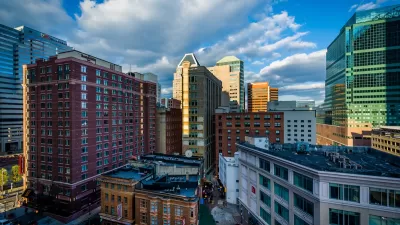Yepoka Yeebo reports on Baltimore's newest plan to deal with the tens of thousands of abandoned houses that mar the city.
Past efforts by Baltimore to raffle for $1, to demolish, and to refurbish the city's estimated 46,800 vacant houses and lots (16% of the city's housing stock) have proven unsuccessful. Now, the city it trying a new approach, ignoring most of them and focusing its limited funds on the most viable housing markets, writes Yeebo.
Yeebo spoke about the city's strategy change with Ira Goldstein, director of policy solutions at The Reinvestment Fund, who produced the assessment that Baltimore used to pinpoint stronger neighborhoods.
"'Too often, what we've done with the allocation of federal dollars cities get, is just find the poorest, most distressed place, and dump as much as you can in there, and see what happens,' he said. The results were weak, Goldstein explained, because the city would renovate houses no one wanted to buy. The money would be better-spent spurring interest in more attractive neighborhoods."
"As for the rest of the abandoned properties, where it can afford to, the city will still be dealing with the most dangerous structures. Eventually, the plan calls for demolishing the most distressed housing, and holding onto the land until there's scope for large-scale development," explains Yeebo.
FULL STORY: Baltimore Decides Some Neighborhoods Just Aren’t Worth Saving

Planetizen Federal Action Tracker
A weekly monitor of how Trump’s orders and actions are impacting planners and planning in America.

Map: Where Senate Republicans Want to Sell Your Public Lands
For public land advocates, the Senate Republicans’ proposal to sell millions of acres of public land in the West is “the biggest fight of their careers.”

Restaurant Patios Were a Pandemic Win — Why Were They so Hard to Keep?
Social distancing requirements and changes in travel patterns prompted cities to pilot new uses for street and sidewalk space. Then it got complicated.

Platform Pilsner: Vancouver Transit Agency Releases... a Beer?
TransLink will receive a portion of every sale of the four-pack.

Toronto Weighs Cheaper Transit, Parking Hikes for Major Events
Special event rates would take effect during large festivals, sports games and concerts to ‘discourage driving, manage congestion and free up space for transit.”

Berlin to Consider Car-Free Zone Larger Than Manhattan
The area bound by the 22-mile Ringbahn would still allow 12 uses of a private automobile per year per person, and several other exemptions.
Urban Design for Planners 1: Software Tools
This six-course series explores essential urban design concepts using open source software and equips planners with the tools they need to participate fully in the urban design process.
Planning for Universal Design
Learn the tools for implementing Universal Design in planning regulations.
Heyer Gruel & Associates PA
JM Goldson LLC
Custer County Colorado
City of Camden Redevelopment Agency
City of Astoria
Transportation Research & Education Center (TREC) at Portland State University
Camden Redevelopment Agency
City of Claremont
Municipality of Princeton (NJ)





























